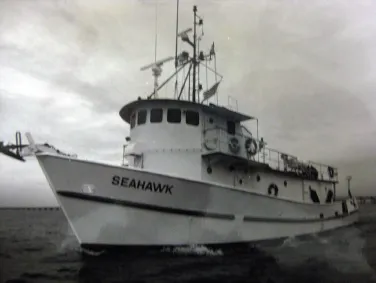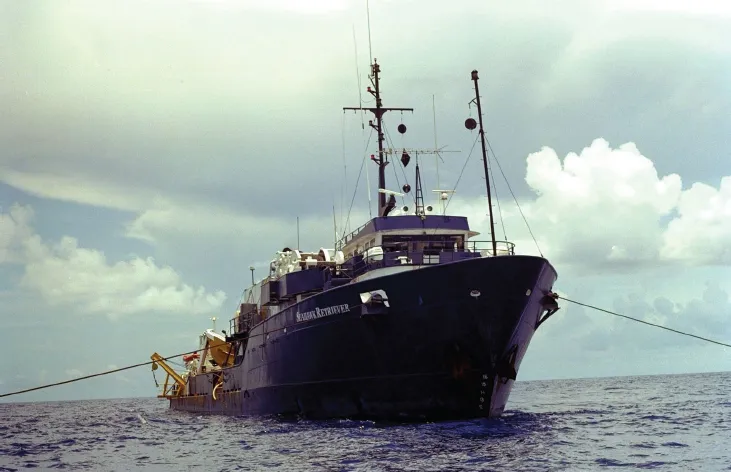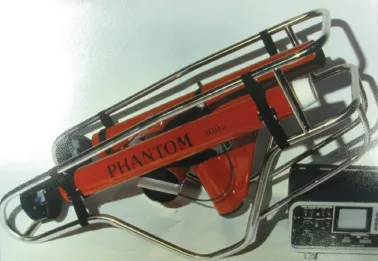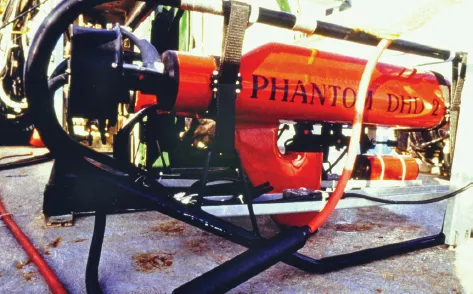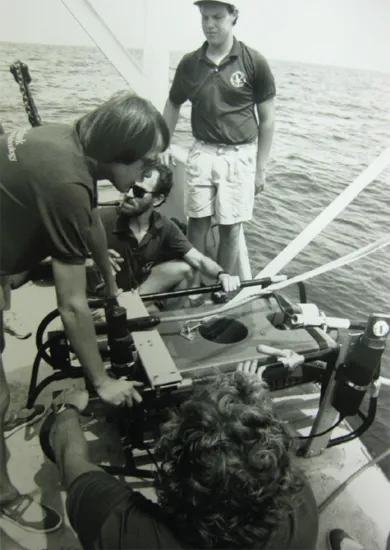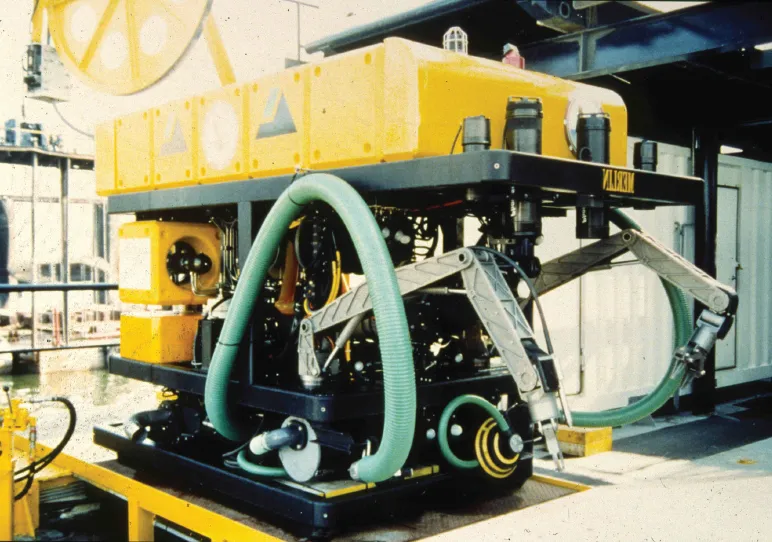![]()
The Deep-Sea Tortugas Shipwreck, Florida: Technology
John Astley
Tortugas Shipwreck Project Offshore Manager, Seahawk Deep Ocean Technology
Greg Stemm
Odyssey Marine Exploration, Tampa, USA
Between 1989 and 1991 Seahawk Deep Ocean Technology of Tampa, Florida, conducted the world’s first robotic excavation of a deep-sea shipwreck, in this case lost in 405m off the Tortugas Islands in the Florida Keys, USA. The study of this merchant vessel from the 1622 Spanish Tierra Firme fleet required the development of cutting-edge technological solutions ranging from an appropriate research ship to a sophisticated Remotely-Operated Vehicle. The latter was custom-tooled with a specialized pump and suction system, which included a limpet device to lift delicate artifacts and a Sediment Removal and Filtration (SeRF) filtering unit to save small finds recovered during the extraction of sediment spoil. The Tortugas shipwreck’s technology package successfully enabled 16,903 artifacts to be recorded and safely recovered.
© Odyssey Marine Exploration, 2013
1. Introduction
In July 1989 when the location of the Tortugas shipwreck was first identified using a Deep Ocean Engineering Phantom ROV (Remotely-Operated Vehicle), underwater technology was developing at a rapid rate due to vast budgets being made available for complex projects across the world. Between 1978 and 1988 the offshore oilfield industry had made significant advances in their capabilities for deep-sea work ranging from pipeline surveys to offshore oil rig support and inspection.
The navigational precision of the data demanded for rig support and the laying of oil pipelines needed to be to centimetric accuracy in critical areas near structures and lesser (1m) in open water. These systems were highly automated: data recorders only needed to press one or two keys to record all positional data and references to video, still photographs and anomaly identity. Seahawk chose to adapt recognized and well-developed offshore oil and gas technology to the recording and recovery of artifacts from the Tortugas shipwreck as the most realistic and efficient methodology for a scientific deep-sea excavation.
While some cursory exploration and salvage work had been accomplished on other deep shipwreck sites, the excavation of the early 17th-century Tortugas shipwreck represented the world’s first comprehensive archaeological excavation of a deep-sea shipwreck entirely remotely using robotic technology. The project called for appropriately respectful technology suited to the removal of sedimentary overburden, accurate positioning and recording systems, as well as sensitive artifact recovery tools. The project resulted in the recovery of 16,903 artifacts, ranging from gold bars to ballast stones and extensive ceramics, animal bones, pearls and tiny seeds, and the procurement of an enormous quantity of scientific data in the form of video, still photographs and records. The Tortugas shipwreck excavation’s pioneering technology package served as the backbone to the archaeological reconstruction of this shipwreck.
Fig. 1. The 86ft-long research vessel RV Seahawk.
Fig. 2. The Seahawk Retriever in port. Photo: John Astley.
Fig. 3. The Seahawk Retriever anchored over the Tortugas shipwreck site on a four-point mooring. Photo: John Astley.
Fig. 4. A DOE Phantom 300 ROV used for visual reconnaissance from the RV Seahawk.
2. Survey Equipment
The operation’s platform used during the Tortugas shipwreck survey was the 26.2m-long research vessel Seahawk (Fig. 1), equipped with side-scan sonar, sector-scanning sonar, magnetometer, a multi-target acquisition/tracking system, an integrated navigation system, Remotely-Operated Vehicles, HF, VHF radios and a very long range cellular telephone. The integrated navigation system was capable of generating search grids and graphically displaying the real time position of the research ship. The side-scanning sonar (consisting of a Klein 590 paper recorder, a 100/500 khz towfish, a Sintrex high-resolution magnetometer and an EG & G magnetometer), a Mesotec 971 and UDI sector-scanning sonar, a Loran C Integrated Seatrac Navigation System, and a Track Point II Dynamic Relative Positioning System facilitated the initial survey.
The side-scan sonar featured transducers on a tow fish that emitted and received acoustic pulses, which were transmitted to the research vessel. The data from the Klein side-scan sonar tow fish (100/500 khz) were transmitted to a model 595 recorder for processing. The system was able to record a swathe of up to 300m to each side, depending on the frequency. Conditioned by density and material, features and objects rendered a dark silhouette created by acoustic shadows on thermal paper, which fed out of the recorder at a speed proportional to the tow fish’s movements along the survey lines. The resulting image provided a detailed representation of the ocean floor features and characteristics: an accurate picture of a wide area, which could be interpreted to construct a three dimensional image of the seafloor’s contours.
Aboard the RV Seahawk were three ROV’s equipped with video and still cameras to provide visual access and documentation in deep water, and a manipulator device that enabled the mechanical retrieval of artifacts. The largest and most versatile of the ROV’s was a Phantom DHD2, custom built for this project by Graham Hawkes of Deep Ocean Engineering. The DHD2 had a depth rating of 610m, a low-light color video camera and relatively simple articulated arm (Figs. 5-6). A Phantom 500, with a depth rating of 150m and a color video camera, was a mid range ROV. Finally, a Phantom 300, with a depth rating of 90m and color video, functioned in shallow water (Fig. 4). The RV Seahawk was capable of holding station under its own power without anchoring by ‘liveboating’ the vessel during ROV operations.
Figs. 5-6. The initial visual wreck survey was accomplished using a Phantom DHD2 ROV (top) being launched by Scott Stemm, Dr. James Cooke, David Six and Steve Dabagian.
Fig. 7. The 3-ton ROV Merlin built for the Tortugas shipwreck excavation; with its SeRF system hose and nozzle at front right, two manipulator arms and limpet suction device at center. Along the badge bar are two 35mm cameras and two 70mm still cameras.
Initial visual survey of the wreck site was accomplished using the Phantom DHD2 ROV (Figs. 5-6), which was equipped with a Mesotech 971 sector scanning sonar and was utilized to define the location and perimeter of the site. The ROV was linked to Seahawk via 610m of shielded 42 separate conductor umbilical cable (no single wire multiplex control system was available in 1990-91) and was fitted with two 250-watt halogen lights and two Panasonic CCD low light video color cameras to illuminate the site. The Phantom DHD2 had a single function manipulator arm to provide dexterity for the retrieval of artifacts and was equipped with an ORE multi-beacon, which emitted an analog signal received by a Trac Point II tracking system. DHD2, with dimensions of 0.6 x 0.9 x 1.2m, including its protector bars, weighed approximately 68kg and was propelled by six thrusters. The pilots flew the ROV using a ‘joy stick’ control and observation via a small TV monitor mounted in the control console. A ‘co-pilot’ managed the camera adjustments, recorders and manipulated the retrieval arm.
The launch system onboard the RV Seahawk consisted of a winch, an A frame, armored tether and depressor weight that allowed ROV operations to be conducted in depths of up to 600m of water. The ROV was free-swimming, relying on the depressor weight connected to the armored umbilical, with a 50m neutrally buoyant excursion tether from the depressor that provided a 100m footprint for the ROV.
The video survey of the Tortugas deep-water wreck initially revealed a shipwreck site measuring approximately 15m long and 10m wide characterized by wooden hull remains, piles of ballast stone and numerous 17th-century olive jars. All videotapes recorded throughout the excavation were, and continue to be, held for permanent reference.
3. Excavation Equipment
In order to commence excavations with suitable technology, a second vessel, the 64m-long Seahawk Retriever, was dispatched to the site in May 1990 (Figs. 2-3). Originally called the Tera Tide, this vessel was built in 1974 by Burton Shipyard, Texas, as a twin screw supply vessel for transporting and pump drilling mud in the oilfields of the Gulf of Mexico. Of welded steel construction, and with a flush deck aft and raised deck forward, a model bow, square stern and steel deckhouse, the ship was retro fitted for the Tortugas shipwreck excavation with low pressure Bratvaag winches for managing a four point mooring system (Fig. 3), cranes for hoisting equipment an...


